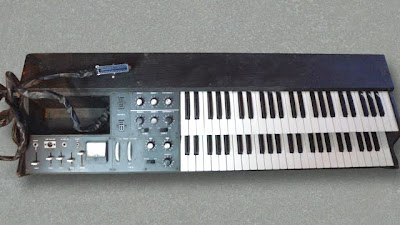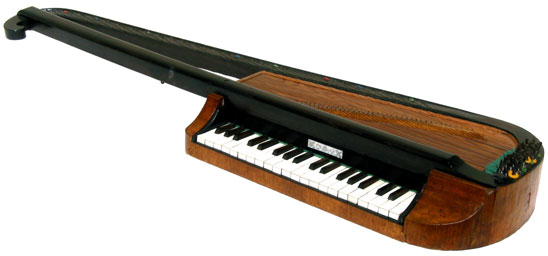via The Bob Moog Foundation.
"Pioneering synthesist Roger Powell recently donated his custom keyboard controller to the Bob Moog Foundation Archives. In a special post dedicated to the controller, BMF Archive and Education Specialist Marc Doty explores the unique history and functionality of this one-off design created by Bob Moog himself.
Interested in donating your piece of history to the Bob Moog Foundation? Please contact us at info@moogfoundation.org."
 From the article (do check out the full post for the history and full story. The following focuses only on the features): "Bob and Roger worked together to create a keyboard controller that could harness the power of two modular synthesizers in real-time through a single, convenient interface. A challenge was to do this while meeting Powell’s requirements for advanced controls over the dynamic and expressive qualities of the sound. The controller began its life as a Moog 951 keyboard, but a lot of features were added. The custom controller’s features included:
From the article (do check out the full post for the history and full story. The following focuses only on the features): "Bob and Roger worked together to create a keyboard controller that could harness the power of two modular synthesizers in real-time through a single, convenient interface. A challenge was to do this while meeting Powell’s requirements for advanced controls over the dynamic and expressive qualities of the sound. The controller began its life as a Moog 951 keyboard, but a lot of features were added. The custom controller’s features included: Two keyboard manuals, allowing independent patches on the two modular synthesizers to be played at the same time.
Two keyboard manuals, allowing independent patches on the two modular synthesizers to be played at the same time.A pitch wheel.
A modulation wheel.
Individual scale, range, portamento settings, and portamento switches were installed for each manual. These could set for each keyboard individually, or combined to control both keyboards at the same time.
A built-in mixer section with four faders, to manage the sound of the two synths. This custom Bob Moog-designed mixer allowed Roger to easily manage the loudness of various patches and effects he was using in a live setting.
A volume control for the Echoplex delay unit Roger used with the system.
A VU meter for measuring the relative amplitude of the synthesizer output.
A headphone jack, headphone volume, and output on/off switch that allowed Roger to preview tuning and patch changes before making them audible to the audience.
Two “accessory” ports for a Ribbon Controller and a standalone Sample/Hold module.
The keyboard module interfaced with the modular systems through a special cable and connector port. This cable carried the control voltages from the two manuals, accessories, and modulation/pitch wheels and distributed them to the proper synthesizer modules. The cable also had several tracks of audio return which came back into the keyboard from the audio output of the modular; their loudness was individually controlled by the Bob Moog custom-designed mixer. The total output of the synthesizer, came out of the system’s Line Level Out XLR jack."
























































